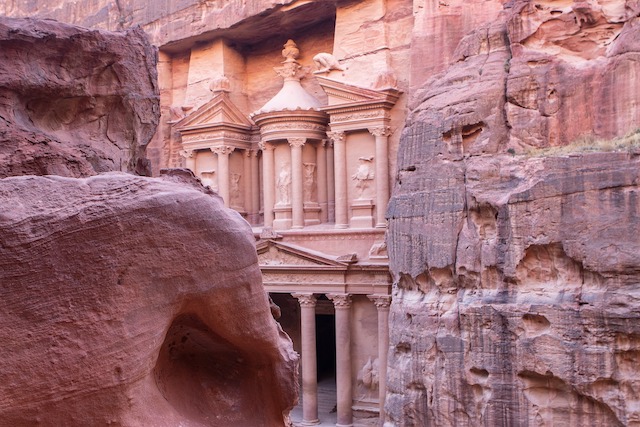Today, the religiously and socially conservative nation of Saudi Arabia is not only at the center of the world geographically, but also at the center of terrible contradictions. For example, airstrikes in Yemen, its neighbor at the southern tip of the Arabian Peninsula, have killed some 24,000 people, and allies like the United States are deeply complicit in crimes including the destruction of school buses. Arab business interests have become closely intertwined with, and publicly in conflict with, all sorts of American enterprises, from the Professional Golfers Association of America to World Wrestling Entertainment.
Can the answers to how this country got to this strange place be found in its origins? Not the modern founding of Saudi Arabia in 1932, but in ancient times. At least a millennium ago. In the days when the Arabian Peninsula was a climatologically very different place, when the seeds of the society we see today were sown.
10. Art on the rocks
Although artistic depictions of animals and humans are forbidden by Islamic doctrine, go back a few centuries before the Prophet, and there are areas of Saudi Arabia where such works were in vogue. By far the largest surviving ancient collection is Bir Himah, located about thirty kilometers north of the city of Najran in southeastern Arabia, near the border with Yemen. The site is so rich in art that a 1952 expedition claimed that a person could stand in one spot, turn 360 degrees, and see more than 250 frescoes.
For historians, the art has been invaluable as an unintended timeline using carbon dating. The most popular subject for the glyphs were domestic animals. Since the earliest glyphs date back to around 7000 BC, it was determined that the locals had already domesticated cattle by that time. There were depictions of cattle with stripes and other patterns on their skins, giving intriguing hints about long-extinct species. There are also ostriches and other species that are no longer found in the area, and at the other end of the spectrum, it was brought closer when the common camel was now present. Consequently, the site was declared a UNESCO World Heritage Site in 2021.
9. The ancient ban on veils

While women covering themselves with burqas and other veils is commonly associated with Islam in many cultures (though how far the Quran prescribes these measures is much debated), the practice again predates the Prophet's arrival in the Middle East by millennia. It also extends far beyond the Middle East, so that even ancient Indian cultures had widespread use of the chador centuries before Christ.
In Arabia, this practice acquired a curious peculiarity. Since the chador was associated with modesty and purity, it was considered that it should be reserved for the upper classes. Consequently, there was a period when prostitutes and other women of the lower classes were forbidden to wear the chador.
8. Ancient coffee

Before large oil fields were discovered in the Arabian Peninsula on March 3, 1938, Saudi Arabia's most famous export was coffee, according to Diniz Balcavage's 2001 book "Saudi Arabia" , the practice of drinking coffee began around 800 AD, when a goat herder named Khalid was looking for a way to keep his energy in his head. When he watched his goats eat coffee beans, they seemed unusually alert, so he shared his findings with his fellow Bedouins.
Some sources claim that it took several centuries for coffee to reach its modern form, so around 1300 CE it was confirmed that roasted and brewed coffee was being prepared as a drink, with the technique first being adopted in or around Yemen. For a long time, the most common use of coffee, whether chewed beans or brewed, was to keep Muslim worshippers awake and alert during religious rites. So it is perhaps not surprising that while the Arabs used coffee to analyze texts, the Catholic Church initially declared it a drink of the infidels.
7. The Origins of Birth Control in Islam

Birth control in all its forms is still a controversial issue, especially in fundamentalist religious countries. Saudi Arabia is no exception, as its government banned birth control in 1975, especially the import of Western pills for this purpose. Even such a seemingly innocuous methodology as the rhythm technique is often frowned upon.
This would have been quite surprising to many ancient Saudi Arabians, even long after Islam had become the dominant religion. As explained inEncyclopedias of Birth Control" Verna L. Bullough 2001 , Arab scholars were still writing and sharing texts on how to prevent conception, and even how to perform abortions, in the 10th century. This attitude was undoubtedly influenced by the proximity of such eminent scholars as Muhammad ibn Zakariya al-Razi and Ibn Sina in Persia, who were sufficiently supportive of birth control to compile as many as 20 contraceptive methods during their careers. Knowledge of birth control was so widespread in ancient Saudi Arabia that many methods were exported to Europe. Notably, the Quran itself was generally considered vague on the subject, so that even some more conservative Muslim communities permitted abortions in the fourth month.
6. European slaves

One of the most infamous aspects of Arab history is the slave trade, which historians generally date back to the period from the 7th century to 1900 CE. At first, according to Professor Tidane N'Diya, the Arab slave trade primarily imported European slaves. This ended as the Muslim conquests in Europe wore off and gradually shifted to importing slaves from East Africa. The historical record of how these European slaves were integrated into larger Arab society is patchy, although it is noted that Muslim armies included European slaves in units such as Rumi or the famous Mamluks.
It is fairly well documented that the Arabs did not establish European slave plantations for long. This is because in 869 CE a slave revolt known as the Zanj Revolt broke out and lasted until 883 CE. Although it took place in modern Iraq rather than the Arabian Peninsula, and the slaves were African rather than European, the message of the disasters that could result from the accumulation of large, segregated slave populations was loud and clear throughout the Middle East.
5. Flexible Monotheism

Although the supposedly monotheistic belief in the God of Abraham was prevalent by the time of Muhammad, many Arabs were very flexible when it came to the number of gods they were willing to worship. Authors books "History of Muslim Civilization" Hussein Abiwa and Noura Durki have explained how many Arab tribes picked and chose gods from other religions as they saw fit. For example, just south of Mecca itself, there was a temple dedicated to the Roman goddess Venus herself. Muhammad’s own grandfather claimed to believe in both Allah Ibriham and the completely unrelated moon god Hubal, despite the sinful nature of worshiping multiple gods according to Allah. The prevailing justification seemed to be that Allah was simply delegating some powers to his fellow deities.
For those who felt no allegiance to Allah at all, the number of gods could indeed become overwhelming. For example, the one surviving pre-Islamic temple that became the Kaaba, the holiest site before Islam, housed idols of various gods. By comparison, ancient Greek mythology counted 12 deities in its pantheon. The Kaaba was the site of 360 gods, including the Prophet himself before he received the word from Allah. All of these idols were destroyed with the advent of the new dominant religion.
4. The scent of Allah's rose

Beyond the coveted aroma of freshly brewed coffee, the rest of the world owes much to Saudi Arabia for the scenting of civilization. While the Egyptians had been filling their rooms with myrrh for centuries and ancient Rome used lavender to keep their homes feeling fresh, Arab chemists (though they called themselves “alchemists” at the time) introduced the practice of distilling alcohol to create fragrances. With the decline of the perfume industry in Europe after the fall of the Western Roman Empire, a hole was left in the market that gave Arab traders a long-lasting, virtual monopoly. Lucrative trade routes to Europe opened up after the Crusades, though many Arabs presumably would not have considered them worthy of consideration.
Despite the potential for decadence, these scents were warmly endorsed by Muslim clerics, who claimed that they represented “the wisdom and purity of Allah.” When the aforementioned physician Avicenna applied alcohol distillation to roses, he created a product that became a household staple for centuries. However, it was initially distributed to pharmacies for its supposed healing properties. Eventually, it became common to leave a bowl of rose water for the family to perk up.
3. Al-Arda
Those with a passing knowledge of Islam are probably most aware of the early and rapid conquests of Muslim armies. Warfare was deeply ingrained in Arab culture long before the rise of Islam, and one of its most characteristic expressions was a ritual called al-Arda ("the show"). The most popular and enduring form of this ritual is the Najd Arda, named after the region in which it originated. Bedouin nomads are generally credited with creating the dance.
For a classic Arda, two lines of troops would be lined up. A verse of poetry would be recited, then in unison, the men would perform a choreographed dance to either show off their sword skills or gain fame. The movements would be accompanied by music played on flutes, clarinets, trombones, and drums called tahmeer. These dances could be quite complex, with up to 50 lines of poetry recited between dance numbers. In a nod to modernity, many performances would feature dancers carrying a pistol in their belts. Today, the dance has enough cultural significance that it has been performed by presidents Nicolas Sarkozy, George W. Bush, François Hollande, and Donald Trump.
2. Musical pioneers

The ancient Arabs also made important changes to the musical world away from the battlefield. Most importantly, it was the rabab, which is the first known instrument to use a bow, earning it the nickname “Arabic violin.” The exact date of its invention is unknown, but it is well documented how the Arabs introduced the instruments to Europe via Islamic Spain, and how they served as a direct inspiration for the European counterfeit, the rebec, which itself was a precursor to violas and violins.
Arab music theorists attempted to formalize and standardize music. In the ninth century CE, a system of written musical notation was invented. In the 10th century, Ab? al-Faraj al-Iban? wrote The Book of Songs, which was an authoritative compendium of the music and customs of the era. However, according to a book by Orla Duanne and James McConnachie "World Music: Africa, Europe and the Middle East" 1999, most Arab musicians did not bother to check the notes at all, preferring to memorize songs by ear and perform them as they were memorized. Given that Arab folklore was popular at the time the lute was invented, when Adam Lamak's grandson took his dead son's leg and turned it into a song to mourn his dead son, it is not surprising that this is a community that has generally rejected an academic approach to music.
1. Nabataeans

Much of ancient Arab history is not well documented, but at the heart of the region lies a particularly intriguing cultural mystery, even by its grim historical standards: Who were the Nabataeans? For written history, we have to rely mostly on secondary sources. Roman and Greek documents say they were a group that gained so much wealth from the incense trade that they were able to create stunningly beautiful stone monuments like Petra (likely familiar to readers from the final act of the 1989 filmIndiana Jones and the Last Crusade). ).
Then the Romans conquered them and incorporated them into the empire in 106 AD. Apart from a bunch of mysterious graffiti scattered across their monuments, that’s about it. That’s very little for a country roughly the size of Belgium, which left behind architectural wonders. A campaign to correct this major historical oversight was launched in 2019, involving 60 experts. With over 2,000 square miles of territory to study, they’ve apparently got a lot of work ahead of them.
When Dustin Kosky isn't looking to the past, he's looking to the future, writing horror comedies like " Return of the Living" , a novel about the afterlife of ghosts after the apocalypse.













Оставить Комментарий